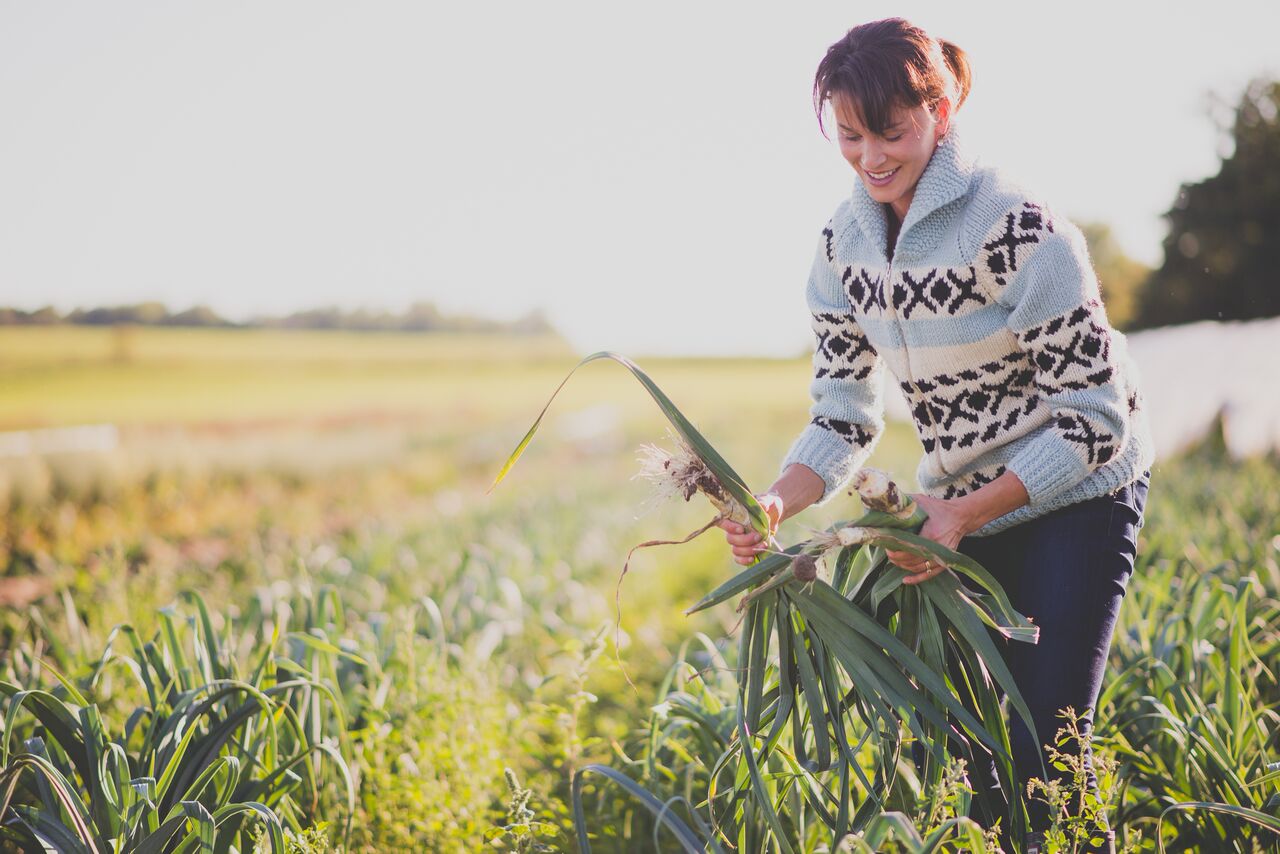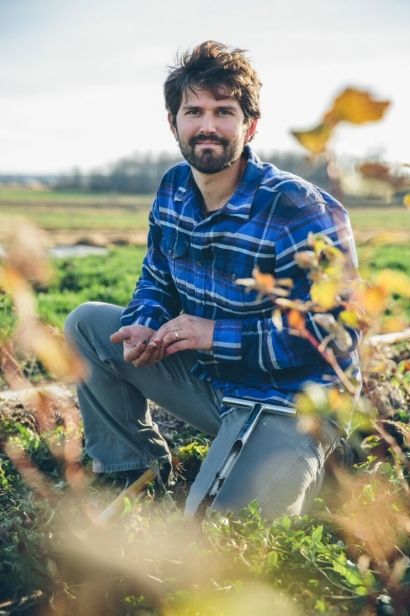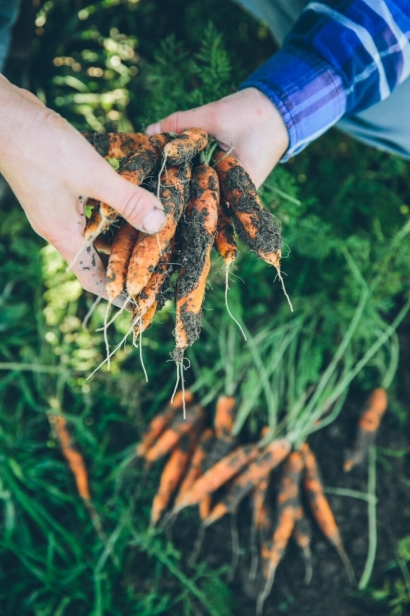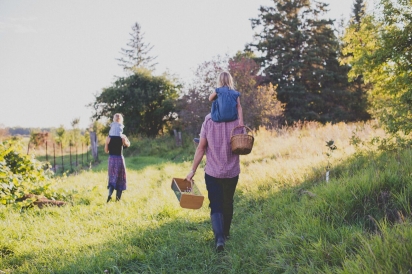Growing by Design
While their troubles might not melt like lemon drops, Zach Loeks and Kylah Dobson are living and working the land they once dreamed of and singing their own lullabies. This hard-working, food-loving, husband-and-wife team own and operate Rainbow Heritage Garden, an innovative farm with award-winning practices, located on this side of the rainbow. That's right: it's in Cobden, Ont. By their ingenuity and creativity, they are cultivating a life for their young family on a farm that is digging deeper into that magical connection between the soil and the food it produces.
Loeks and Dobson are ardent practitioners of permaculture, a set of agricultural and social-design principles inspired by the patterns that occur in natural ecosystems. In fact, permaculture principles drive virtually everything they do on their 50-acre farm, from cultivating quality produce for their CSA members to caring for the land and educating people about food and farming.
Permaculture centres on the idea of working with nature instead of against it, observing it thoughtfully and maximizing useful connections among land, plants, wildlife and other elements to create a designed, synergistic whole that is greater than the sum of its parts. Loeks says it’s an approach that helps reduce waste, makes better use of local resources, builds better soil and ecosystem health and works with nature to grow more food with less work.
Take a carrot, for example. One bite out of a fresh-picked carrot and you get a mouthful of tasty, nutritious food. But making food isn’t all the plant does. For one thing, its colourful taproot helps break up the soil. Its feathery green tops make good mulch and its white flowers produce nectar for pollinators. “Once you’re aware of all the services a crop provides, you begin to see how it works with other crops in mutually beneficial ways,” says Loeks. “Then you can start to design a sustainable food landscape, whether you’re a farmer or a backyard vegetable gardener.”
"Permaculture applies to farming and gardening, but you can apply it to anything,” he adds. “It promotes long-term sustainability by allowing you to get multiple functions from any one investment.” And when he said anything, he meant it — he even applies it to the farm’s use of Rubbermaid storage bins. “Not to get hippy-dippy about it, but a storage bin has innate energy that should be-respected. For example, in winter, we use the bins to make ice blocks for our root cellar that keep the produce cool all summer. Later on in their lifecycle, when the bins aren’t as good for carrying things, we store veggies in them.”
The couple’s dedication to permaculture, along with their energy and hard work, has yielded impressive results. In the 10 years since they launched the CSA, they’ve grown it to 150 regular members. They raise more than 100 kinds of vegetables (plus many varietals of each), along with fruits, nuts, grapes, berries and seeds and also cultivate 80 types of garlic, making them perhaps the most biodiverse garlic producer in Canada.
Their farm and time is devoted to educational purposes too. Each year, they train apprentice farmers onsite and host thousands of visitors who come to the farm for seasonal celebrations, kids’ camps and workshops on cooking and wellness, organic gardening, permaculture, farm design, root cellaring and off-grid living.
The pair has won two Premier’s Awards for Agri-Innovation — one in 2010 for its unique off-grid energy system, and the other in 2014 for the 640-square-foot commercial in-ground root cellar where they store produce at optimal temperatures year-round. These innovations have made Rainbow Heritage Garden one of a handful of farms in North America that operates almost entirely with renewable solar, geothermal and gravity-fed energy.
Besides farming and teaching, Loeks consults on farm and market garden development, teaches soil science at Algonquin College, and is in the throes of writing and illustrating his first book, The Permaculture Market Garden, slated for publication this fall.
Dobson has just become a certified holistic nutrition therapist, adding further value to the cooking and nutrition classes she conducts in the farm’s commercial kitchen. A trained yoga instructor, she intends to introduce yoga to the farm’s roster of classes this year.
In line with their permaculture beliefs, she and Zach regard their various food production and education activities as mutually beneficial ways to enhance the farm’s resilience and profitability. “Resilience depends on balancing your profit centres,” Zach points out. “Don’t put all your eggs in one basket... and have more than just eggs in it!"
The couple first met at Concordia University in Montreal, where they were studying ecology and shared a love of the outdoors and a passion for growing and cooking good food. Loeks was raised on a permaculture homestead in Santa Fe, New Mexico, and launched his own permaculture landscaping business before moving to Québec. Dobson grew up on a farm — the Dobsons are sixth-generation farmers who operate Dobson Grass-fed Beef Farm. She also gained experience doing market gardening and volunteering at farms in Central America.
After university, she and Loeks did a stint of ecological research in northern Québec before deciding to farm on their own. With the help of a few grants, they launched a CSA on the Dobson farm in 2006, later purchasing 50 acres of the family property and dedicating 15 of those to a certified organic market garden.
Among the changes made to the property over the years, the couple has made it a priority to improve the health and fertility of the soil by working it infrequently and strategically, planting cover crops, and using green manures and compost. They have also planted 500 sugar maples and incorporated orchards, forest gardens and irrigation ponds to boost the farm’s resilience. Slowly increasing perennial production is a great permaculture solution for a changing climate and changing economy, Loeks explains. The capacity to produce more fruit, nuts, berries and mushrooms promotes biodiversity as well as greater diversity of crops, income and knowledge.
While they admit to working every chance they get, the couple does find time to relax. Dobson unwinds with yoga, hiking and being outside with daughters Dayvah, 6, and Rainah, 3. Loeks clears his head walking around the farm property or in the mountains. He’s also a lifelong doodler, a tendency he indulges in the book he’s writing on permaculture. “There will be drawings on every page,” he grins.
Since sustainability is one of the main tenets of permaculture, it’s not surprising that Dobson and Loeks have a long-term plan for Rainbow Heritage Garden, one that respects their limits and their resources. “The economy is within the natural system, not the other way around,” Loeks says. “You’ll make better decisions and be more profitable if you start with nature and mimic the relationships you find there." Consider what the land will be good for and the direction the wind is blowing. Determine the characteristics of the atmosphere, the water supply and the soil. "Don’t move forward blindly — design a plan for 10, 20, 50 years and adapt it as needed."
Besides adding perennial plants, their future holds more research and education projects on the farm, and a conscious choice not to expand their CSA much beyond 150 members. For them, real sustainability isn’t about constant growth, but about improving efficiencies and developing the healthiest soil possible.
Rainbow Heritage Garden
81 Stafford Second Line, Cobden, Ont.
rainbowheritage.ca, 613.646.7428
7 Tips for using permaculture in your garden
You don’t have to be a farmer to practise permaculture, says Zach Loeks of Rainbow Heritage Garden. By making changes like these, you can gradually improve the health, productivity and resilience of your home garden.
Observe your soil. Test it, learn about its structure and fertility, and value its diversity.
Map your property and look for soil patterns. Design with these patterns in mind to determine what groups of complementary crops will work best in each area.
Maximize cover crops to manage soil erosion and fertility, water, weeds, pests, diseases, and biodiversity. These can include winter rye, clover, buckwheat, oilseed radish, oats and peas.
Feed the soil. Add compost and inoculate it with mycorrhizal (a symbiotic mixture of fungi and plant roots) and other living soils.
Grow more than just food in your garden system. Include crops that provide organic matter, shade, nectar for insects and so on.
Look for opportunities to companion plant. It benefits the plants and soil.
Observe your garden system over time to make sure that it is self-regulating and tweak it as needed. For example, your notice that your soil is healthier, but you need to reduce surface debris because planting has become less efficient.









